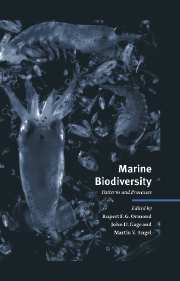Book contents
- Frontmatter
- Contents
- List of contributors
- Foreword: The value of diversity
- 1 Marine biodiversity in its global context
- 2 Gradients in marine biodiversity
- 3 Pelagic biodiversity
- 4 Biological diversity in oceanic macrozooplankton: More than counting species
- 5 Large-scale patterns of species diversity in the deep-sea benthos
- 6 Diversity, latitude and time: Patterns in the shallow sea
- 7 High benthic species diversity in deep-sea sediments: The importance of hydrodynamics
- 8 Diversity and structure of tropical Indo-Pacific benthic communities: Relation to regimes of nutrient input
- 9 Why are coral reef communities so diverse?
- 10 The biodiversity of coral reef fishes
- 11 The historical component of marine taxonomic diversity gradients
- 12 Population genetics and demography of marine species
- 13 Discovering unrecognised diversity among marine molluscs
- 14 Ecosystem function at low biodiversity – the Baltic example
- 15 Land–seascape diversity of the USA East Coast coastal zone with particular reference to estuaries
- 16 The development of mariculture and its implications for biodiversity
- 17 Protecting marine biodiversity and integrated coastal zone management
- 18 Conserving biodiversity in North-East Atlantic marine ecosystems
- Author index
- Species index
- Subject index
7 - High benthic species diversity in deep-sea sediments: The importance of hydrodynamics
Published online by Cambridge University Press: 04 August 2010
- Frontmatter
- Contents
- List of contributors
- Foreword: The value of diversity
- 1 Marine biodiversity in its global context
- 2 Gradients in marine biodiversity
- 3 Pelagic biodiversity
- 4 Biological diversity in oceanic macrozooplankton: More than counting species
- 5 Large-scale patterns of species diversity in the deep-sea benthos
- 6 Diversity, latitude and time: Patterns in the shallow sea
- 7 High benthic species diversity in deep-sea sediments: The importance of hydrodynamics
- 8 Diversity and structure of tropical Indo-Pacific benthic communities: Relation to regimes of nutrient input
- 9 Why are coral reef communities so diverse?
- 10 The biodiversity of coral reef fishes
- 11 The historical component of marine taxonomic diversity gradients
- 12 Population genetics and demography of marine species
- 13 Discovering unrecognised diversity among marine molluscs
- 14 Ecosystem function at low biodiversity – the Baltic example
- 15 Land–seascape diversity of the USA East Coast coastal zone with particular reference to estuaries
- 16 The development of mariculture and its implications for biodiversity
- 17 Protecting marine biodiversity and integrated coastal zone management
- 18 Conserving biodiversity in North-East Atlantic marine ecosystems
- Author index
- Species index
- Subject index
Summary
Abstract
The surprisingly high species diversity found among the mostly smallbodied invertebrates inhabiting the deep-sea sediment is thought to be maintained by biologically generated habitat heterogeneity and patchy food resources acting in concert with biological disturbance at the metre to centimetre scale or less (Grassle & Maciolek, 1992). Disturbance is thought to thin existing populations, and is followed by recolonisation of the disturbed patch, to that the populations never develop to a full competitive equilibrium before the next disturbance event.
This review focuses on the possible importance of larger, >kilometre scale disturbance, generated by currents at the deep-sea floor. Data on species richness and abundance from quantitative benthic samples from five areas presenting varying space–time scales in hydrodynamic disturbance are reviewed, in order to show that such diffuse disturbance of the sediment community resulting from episodes of high bed flow in the supposedly tranquil physical conditions at the deep-sea bed may be an important structuring agent for the deep-sea benthic community. The first area is located at the High Energy Benthic Boundary Layer (HEBBLE) study site on the Nova Scotian continental rise in the North West Atlantic, where the sediment floor periodically experiences strong flow and massive re-suspension during vorticity-driven ‘benthic storms’ and hence where eddy kinetic energy, KE, is very high in the benthic mixed layer.
- Type
- Chapter
- Information
- Marine BiodiversityPatterns and Processes, pp. 148 - 177Publisher: Cambridge University PressPrint publication year: 1997
- 19
- Cited by



